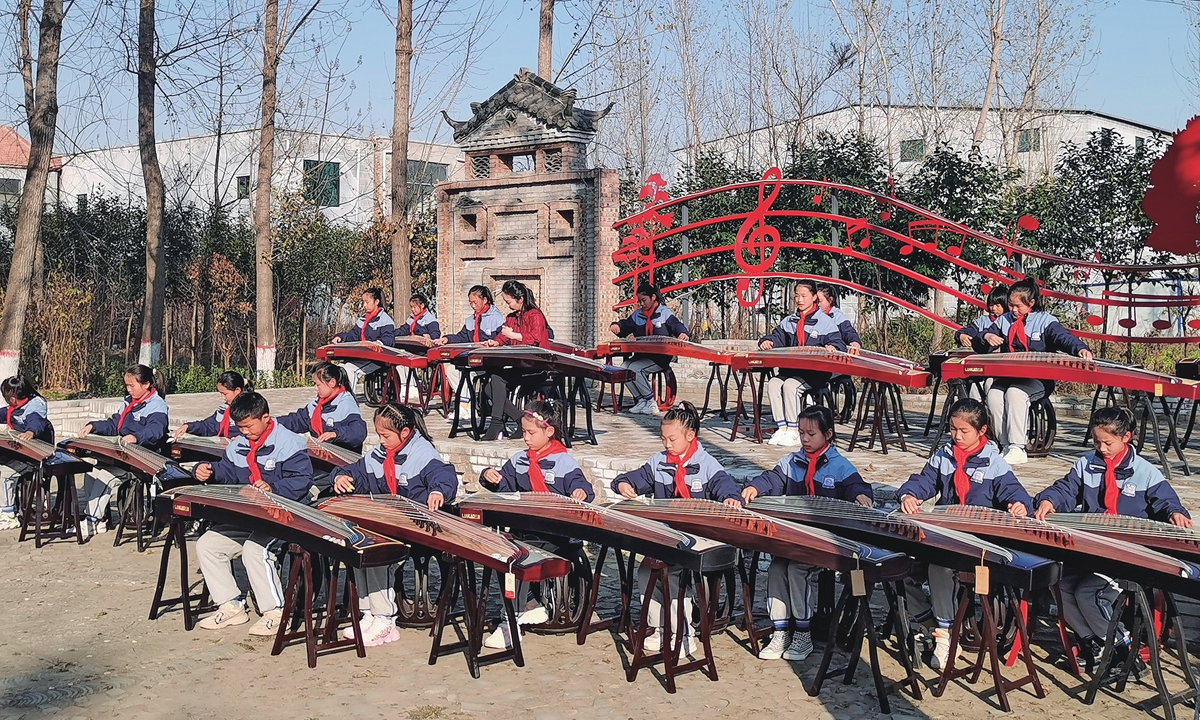
A performance by a guzheng band in Guyang, Lankao county, Central China's Henan Province Photo: Courtesy of Lankao Bureau of Agriculture and Rural Affairs
Walking into Lankao county in Kaifeng, Central China's Henan Province, the local paulownia reserve forest is particularly eye-catching, and upright paulownia trees have painted a bright landscape in the county.
Guyang, a town in Lankao, uses paulownia resources to develop the traditional musical instrument industry, with an annual output of 700,000 sets, accounting for over 30 percent of the domestic market share of traditional musical instruments. The industry provided more than 18,000 jobs for local residents, playing the song of wealth in helping farmers to increase their incomes.
Policy supportThe paulownia tree is a high-quality material for making musical instruments because of its sound-conducting properties and its ability to stabilize the tone well.
Along the road of the Xuchang village, colored paintings of Chinese traditional instruments such as guqin, guzheng and pipa can be seen everywhere on the walls of village houses.
When people walk into local villager Kong Haiguang's house, the sound of cutting and polishing wood echoes in the courtyard. "My instrument studio has annual sales of several million yuan, and I employ five villagers, whose average monthly income reaches more than 10,000 yuan ($1,371.5)," Kong said.
In Xuchang village, there are many other villagers like Kong who make musical instruments for a living, and the rich local timber supply provides them with the raw materials they need for their craft workshops.
Up to now, 90 out of 105 households in the village are engaged in the production of guzheng, guqin, pipa and other musical instruments and accessories.
"In order to alleviate the pressure of the villagers, the government has implemented a tax exemption policy for these musical instrument making enterprises for five years, and has also recommended them to participate in exhibitions across the country, with the government bearing 50 percent of the booth fee, to help them promote their brands," said Xu Shunhai, chief of the village's Party committee.
In addition, in order to help the villagers develop online sales channels, the local government has contacted logistics companies to negotiate prices and door-to-door service with concessions.
At present, the village produces more than 100,000 units of Chinese traditional musical instruments per year, with the annual output value of 180 million yuan,with sales through e-commerce channels reaching 60 million yuan.
Industrial agglomerationIn the commercial street of the music town in Lankao, Zhou Xudong's musical instrument store is well-known due to high quality. In his production workshop, a dozen employees are working in an orderly manner: Some are skillfully cutting the panels of the instrument with machines, some are polishing and sanding the instrument, and others are packing the products.
"Earlier, I was making instruments at home, but the space was too small. I decided to come here when the government encouraged local residents to move into the commercial street," said Zhou, who has 30 years of experience in making musical instruments.
The relocation of small family workshops to the commercial street is a planning effort headed by the local government to support the traditional musical instrument production industry, aimed at promoting the standardization and large-scale development of the musical instrument industry in Lankao, and improving the competitiveness, popularity and influence of the music town in the national market.
The local government gave business owners like Zhou a rent-free policy for the first year and subsidizes half of the rent for the second and third years. For Zhou, after moving from the village, he enjoyed not only the rent concessions, but also the complementary advantages of the upstream and downstream industry chains and the customer flow and market information resources brought by the commercial street.
"In the street I can better understand the market demand, and the perfect supporting facilities and large flow of people are very helpful to increase the sales of musical instruments," noted Zhou.
At present, the commercial street has attracted a total of 45 well-known musical instruments production and supporting enterprises including Shanghai Dunhuang Musical Instruments Co, which have brought the music town a more standardized production process and improved the local industry chain, as well as provided a role model for local business development.
At the beginning of this year, China unveiled its "No.1 central document" for 2023, outlining nine tasks for comprehensively promoting rural vitalization in 2023. Minister of Agriculture and Rural Affairs Tang Renjian said that it is important to cultivate industries and businesses that leverage on local strengths.
The country will strive to ensure that more than 60 percent of the central government subsidies for rural vitalization is used to develop local industries, according to the document.




